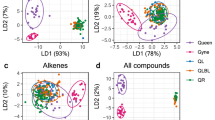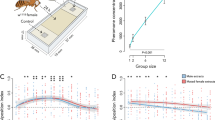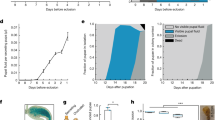Abstract
Hassell and Huffaker1 demonstrated some density-dependent regulation of numbers in populations of the flour moth, Anagasta kuehniella (Zeller). Fighting between newly hatched larvae2 contributes to the regulation of numbers in this species but is not the only controlling mechanism: Smith3 showed that crowding from the end of the first instar onwards led to delayed emergence of adults and a reduction in body weight. Since smaller moths lay few eggs4, both these effects would contribute to the density-dependent regulation of numbers in succeeding generations. I describe here a mechanism which could bring about these effects. I suggest that last-instar larvae of A. kuehniella, when they meet, deposit on the substratum drops of secretion from their mandibular glands; and that the response of other last-instar larvae to this secretion results not only in the regulation of the total numbers of A. kuehniella in a finite system (as studied by Smith3), but also in the control of the dispersion of individuals within that system.
This is a preview of subscription content, access via your institution
Access options
Subscribe to this journal
Receive 51 print issues and online access
$199.00 per year
only $3.90 per issue
Buy this article
- Purchase on Springer Link
- Instant access to full article PDF
Prices may be subject to local taxes which are calculated during checkout
Similar content being viewed by others
References
Hassell, M. P., and Huffaker, C. B., Researches Popul. Ecol. Kyoto Univ., 11, 186 (1969).
Flanders, S. E., Hilgardia, 39, 367 (1968).
Smith, S. D., J. Exp. Zool., 170, 193 (1969).
Ullyett, G. C., and Merwe, J. S. v. d., J. Entomol. Soc. South Afric., 10, 46 (1947).
Wroniszewska, A., J. Insect Physiol., 12, 509 (1966).
Hassell, M. P., J. Anim. Ecol., 40, 333 (1971).
Karlson, P., and Butenandt, A., Ann. Rev. Entomol., 4, 39 (1959).
Wynne-Edwards, V. C., Animal Dispersion in Relation to Social Behaviour (Oliver and Boyd, Edinburgh and London, 1962).
Brown, jun., W. L., Eisner, T., and Whittaker, R. H., Bioscience, 20, 21 (1970).
Vité, J. P., and Williamson, D. L., J. Insect Physiol., 16, 233 (1970).
Vinson, S. B., Ann. Entomol. Soc. Amer., 61, 8 (1968).
ITBON in 1965, Annual Report of Institute for Biological Field Research, Arnhem, Netherlands.
Author information
Authors and Affiliations
Rights and permissions
About this article
Cite this article
CORBET, S. Mandibular Gland Secretion of Larvae of the Flour Moth, Anagasta kuehniella, contains an Epideictic Pheromone and elicits Oviposition Movements in a Hymenopteran Parasite. Nature 232, 481–484 (1971). https://doi.org/10.1038/232481b0
Received:
Revised:
Published:
Issue Date:
DOI: https://doi.org/10.1038/232481b0
This article is cited by
-
Response of the neonate larvae of Cactoblastis cactorum to synthetic cactoblastins, a newly identified class of pheromonally-active chemicals found in the caterpillar’s mandibular glands
Chemoecology (2020)
-
Natural products from Peperomia: occurrence, biogenesis and bioactivity
Phytochemistry Reviews (2016)
-
Trail Following Response of Larval Cactoblastis cactorum to 2-Acyl-1,3-Cyclohexanediones
Journal of Chemical Ecology (2015)
-
The influence of the rearing host on the response of the parasitoid Venturia canescens (Gravenhorst) (Hymenoptera: Ichneumonidae) to odours from Ephestia kuehniella and Plodia interpunctella in a Y-tube olfactometer
BioControl (2012)
-
10.1007/BF00290701
CrossRef Listing of Deleted DOIs (2011)
Comments
By submitting a comment you agree to abide by our Terms and Community Guidelines. If you find something abusive or that does not comply with our terms or guidelines please flag it as inappropriate.



